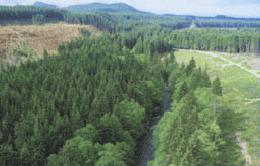On August 22, 1986, the Timber Fish Wildlife Agreement offers a new way to manage state forests by allowing all the stake holders -- tribes, loggers, environmentalists, government agencies -- to develop logging practices together. The agreement avoids the sometimes acrimonious process in which competing interests present sometimes conflicting evidence to the Forest Practices Board which then has to make a decision. Under the new process, the parties develop methods for harvesting timber that still protect the environment.
Under the 1974 Forest Practices Act, the Forest Practices Board promulgated regulations after doing investigations and holding hearings. The board's rules affected two-thirds of the state's commercial forests -- 11 million acres. This placed competing interests in adversarial positions and disputed issues occasionally landed in court. Litigation ran up costs and regulations were stalled for years.
In July 1986, the Northwest Renewable Resources Center convened a conference in Port Ludlow to consider alternative dispute resolution for forest practices. Representatives of the timber industry, tribes, environmentalists, and governmental agencies gathered to work out a new process. Progress was so positive that on August 22, 1986, the group asked the Forest Practices Board to delay its new rules until the stake holders could work out their own plan.
After six months and 60 meetings, the Timber Fish Wildlife Agreement was announced on February 17, 1987. The goals of the agreement were to provide for the environment and for a healthy forest industry. Changes in rules are negotiated among the parties instead of argued before a commission or a court. A three-year moratorium on new regulations allowed the group to formulate its own proposals. Each logging site was dealt with individually based on the best science at the time (adaptive management), rather than on broad and complex regulations. Both fish-bearing streams, and the upland watersheds that supported them, were protected.
The field component of the agreement was the Interdisciplinary Team, specialists who would examine sites and provide answers to technical questions. After permits were issued, the Cooperative Monitoring, Evaluation and Research Committee followed up to examine the success of the management plan.
Signators to the TFW Agreement included
- Washington Forest Protection Association
- Washington Farm Industry Association
- Department of Natural Resources
- Department of Ecology
- Department of Labor and Industries
- Department of Fish and Game
- Washington Environmental Council
- Washington Audubon Society
- Colville Federated Tribes
- Columbia River Intertribal Fish Commission
- Georgia Pacific
- Simpson Timber
- Weyerhaeuser Company
- Yakama Tribe
- Northwest Indian Fisheries Commission

